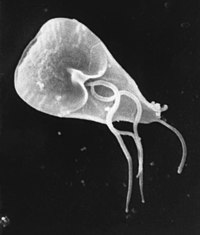Giardia
| Giardia | |
|---|---|

| |
| Giardia trophozoite, SEM | |
| Scientific classification | |
| Domain: | |
| Kingdom: | |
| Phylum: | |
| Class: | |
| Order: | |
| Family: | |
| Genus: | Giardia
|
| species | |
|
Giardia agilis | |
Giardia (/dʒiːˈɑːrdiə/ or /ˈdʒɑːrdiə/) is a genus of anaerobic flagellated protozoan parasites of the phylum Retortamonada in the supergroup "Excavata" (named for the excavated groove on one side of the cell body) that colonise and reproduce in the small intestines of several vertebrates, causing giardiasis. Their life cycle alternates between an actively swimming trophozoite and an infective, resistant cyst. The genus was named after French zoologist Alfred Mathieu Giard.
Characteristics
Like other diplomonads, Giardia have two nuclei, each with four associated flagella, and lack both mitochondria and a Golgi apparatus. However they are now known to possess mitochondrial relics, called mitosomes. These are not used in ATP synthesis the way mitochondria are, but are involved in the maturation of iron-sulfur proteins.[1] The synapomorphies of genus Giardia include cells with duplicate organelles, absence of cytostomes, and ventral adhesive disc.[2]
Infection and symptoms

Giardia lives inside the intestines of infected humans or other animals. Individuals become infected through ingesting or coming into contact with contaminated food, soil, or water. The Giardia parasite originates from contaminated items and surfaces that have been tainted by the feces of an infected animal.[3]
The symptoms of Giardia, which may begin to appear 2 days after infection, include violent diarrhea, excess gas, stomach or abdominal cramps, upset stomach, and nausea. Resulting dehydration and nutritional loss may need immediate treatment. The typical infection within an individual can be slight, resolve without treatment, and last between 2–6 weeks, although sometimes longer and/or more severe. Coexistence with the parasite is possible, symptoms fade, but one can remain a carrier and transmit it to others. Medication containing tinidazole or metronidazole decreases symptoms and time to resolution, albendazole is also used and has an anti-helmintic (anti-worm) property as well, ideal for certain compounded issues when a general vermicidal agent is preferred.
Prevention
Person-to-person transmission accounts for the majority of Giardia infections and is usually associated with poor hygiene and sanitation. Water-borne transmission is associated with the ingestion of contaminated water. In the U.S., outbreaks typically occur in small water systems using inadequately treated surface water. Venereal transmission happens through fecal-oral contamination. Additionally, diaper (nappy) changing and inadequate hand washing are risk factors for transmission from infected children. Lastly, food-borne epidemics of Giardia have developed through the contamination of food by infected food-handlers.[4]
Systematics
About 40 species have been described from different animals, but many of them are probably synonyms.[5] Currently, five to six morphologically distinct species are recognised.[6] Giardia lamblia (=G. intestinalis, =G. duodenalis) infect humans and other mammals, G. muris is found from other mammals, G. ardeae and G. psittaci from birds, G. agilis from amphibians and G. microti from voles.[7] Other described, (but not certainly valid) species include:[8]
|
|
|
|
Genetic and biochemical studies have revealed the heterogeneity of Giardia lamblia, which contains probably at least eight lineages or cryptic species.[9]
Genome
A Giardia isolate (WB) was the first diplomonad to have its genome sequenced. Its 11.7 million basepair genome is compact in structure and content with simplified basic cellular machineries and metabolism. Currently the genomes of several other Giardia isolates and diplomonads (the fish pathogens Spironucleus vortens and S. salmonicida) are being sequenced.[10]
A second isolate (the B assemblage) from humans has been sequenced along with a species from a pig (the E assemblage).[11] There are ~5000 genes in the genome. The E assemblage is more closely related to the A assemblage than is the B. A number of chromosomal rearrangements are present.
See also
References
- ^ Tovar J.; et al. (2003). "Mitochondrial remnant organelles of Giardia function in iron-sulphur protein maturation". Nature. 426 (6963): 172–6. doi:10.1038/nature01945. PMID 14614504.
{{cite journal}}: Explicit use of et al. in:|author=(help) - ^ Cepicka, Ivan. 2008. Fornicata. Version 2 September 2008 (under construction). http://tolweb.org/Fornicata/121182/2008.09.02 in The Tree of Life Web Project, http://tolweb.org/
- ^ Filice, F.P. (1952) "Studies on the cytology and life history of a Giardia from the laboratory rat" U. C. Publications in Zoology. v. 57, no. 2. University of California Press: Berkeley
- ^ Pennardt, MD, Andre. "Giardiasis." EMedicine. 4 Feb. 2004. 20 Feb. 2009 <http://www.emedicine.com/EMERG/topic215.htm>.
- ^ Meyer E.A., Radulescu S. (1979). "Giardia and Giardiasis". Advances in Parasitology. 17: 1–47. doi:10.1016/S0065-308X(08)60548-5. PMID 395833.
no
- ^ R.C.Brusca, G.J.Brusca. Invertebrates. Sinauer Associates, 2 ed.(2003)
- ^ Adam,R.D. Biology of Giardia. Clinical Microbiology Reviews, July 2001, p. 447–475
- ^ Tree of Life Web Project. 2008. Giardia Kunstler. Version 2 September 2008 (temporary). http://tolweb.org/Giardia/97370/2008.09.02 in The Tree of Life Web Project, http://tolweb.org/
- ^ R.C.A. Thompson and P.T. Monis, Variation in Giardia: implications for taxonomy and epidemiology. Advances in Parasitology 58, 69-137 (2004)
- ^ Andersson, JO; et al. (2010). "The Genome of Giardia and Other Diplomonads". Anaerobic Parasitic Protozoa: Genomics and Molecular Biology. Caister Academic Press. ISBN 978-1-904455-61-5.
{{cite book}}: Explicit use of et al. in:|author=(help) - ^ Jerlström-Hultqvist J, Ankarklev J, Svärd SG (2010) Is human giardiasis caused by two different Giardia species? Gut Microbes 1(6):379-382.
